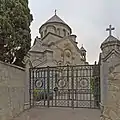Gabriel Ter-Mikelov
Gabriel Mikhaylovich Ter-Mikelov (Armenian: Գափրիել Տեր-Միքաելյան Gabriel Ter-Mikelyan; 16 April 1874 in Stavropol, Russia – 14 January 1949 in Tbilisi, USSR) was a prominent architect of Armenian descent.[1]

Life
According to Gabriel Ter-Mikelov's sister Suzanna Zohrabyan, the family's origins trace back to Karabakh and their original last name was Aslanbekyan.[2] The family eventually settled in Tbilisi. During the occupation of Tbilisi by Mohammad Khan Qajar in 1795, the city was reduced to ashes and its Christian population were massacred.[3] Almost all members of the Aslanbekyan family were murdered except for a two-year child who was saved by an Armenian priest Ter Mikayel. This child, who was the grandfather of Gavriil Ter-Mikelov, took up the Ter-Mikayelian last name and was later known as Ter-Mikelov due to Russification policies of Czarist Russia.[2] His parents were both born in Tbilisi.[4] Ter-Mikelov's father worked in many state run institutions and due to his knowledge of many languages, he was often sent on foreign trips.[4] Ter-Mikelov's mother was an educated woman who graduated the Tbilisi High School of Young Ladies with Golden Cross Honors and eventually became a teacher herself. Gavriil Ter-Mikelov was born in Stavropol on 16 April 1874. He studied in the Tbilisi Realschule and went to St. Petersburg where in 1893 he entered the St. Petersburg Institute of Civil Engineering and graduated from it in 1899.[4] He moved to Baku where he lived and worked till 1912. After moving to Tbilisi, he became a lecturer at the Tbilisi Academy of Fine Arts, Honored Artist of the Georgian SSR, and member of the Academy of Architecture of the USSR.[4] Ter-Mikelov died on 14 January 1949 at the age of 74 and was buried in the Armenian Vera Cemetery in Tbilisi. Gavriil Ter-Mikelov's architectural career lasted for over 50 years. Throughout his career, Ter-Mikelov had drafted 70 projects, 37 of which were completed.
Works
Baku
Gabriel Ter-Mikelov designed Baku Public Club Building (today Azerbaijan State Philharmonic Hall),[1][5] the maternity hospital (1899), the building of the Baku branch of the Tiflis Trade Bank (1902-1903; today “Children's World” department store), the Adamoff Brothers residence, the Sadikhov Residence (1910-1912; Nikolayevskaya street 1; USSR number 21),[6] Physiotherapy Institute, Four-storey Apartment ordered by Taghiyev (Nizami 30, crossroads with Mariinskaya Street), and the Commercial College (1905-1913; Merkurevskaya Street 39).[7][8][9] He was also one of the main architects of the Saint Thaddeus and Bartholomew Armenian Cathedral.[2]
Tbilisi
Under the suggestion of famed Armenian entrepreneur Mikayel Aramyants, Gabriel Ter-Mikelov designed and built many buildings in the Georgian capital such Hotel Majestic (1915; Today Tbilisi Marriott Hotel),[10] residence of the Armenian merchant Melik Dadayan (1915), living house of Milov (1914),[11] former building of railway workers (1950; Today National Musical Center of Georgia).[12] Gabriel Ter-Mikelov was an honored Artist of the Republic of Georgia, corresponding member of the all-Union Academy of architecture, professor at the Tbilisi Academy of Arts. He taught at the Academy until 1949.
Yalta
A church complex was commissioned by oil-magnate P. Ter-Ghukasyan, who wanted to build a church in memory of his daughter, who died in Yalta, Russia. Subsequently, he purchased land area in Yalta for the church to be built. The church was built on a hill with 128 step stairs rising from 2 propylene-chapel shapes.[13]
Gallery
 Azerbaijan State Philharmonic Hall designed by Gavriil Ter-Mikelov.
Azerbaijan State Philharmonic Hall designed by Gavriil Ter-Mikelov. Azerbaijan State Philharmonic Hall designed by Gavriil Ter-Mikelov.
Azerbaijan State Philharmonic Hall designed by Gavriil Ter-Mikelov. Sadikhov Residence in Baku (1910-1912)
Sadikhov Residence in Baku (1910-1912) Physiotherapy Institute of Baku (1929)
Physiotherapy Institute of Baku (1929) Commercial College of Baku (1913)
Commercial College of Baku (1913) The dwelling house of Adamyan brothers in Baratinskaya street (1908)
The dwelling house of Adamyan brothers in Baratinskaya street (1908) Tbilisi Marriott Hotel designed by Gavriil Ter-Mikelov.
Tbilisi Marriott Hotel designed by Gavriil Ter-Mikelov. Yalta Armenian Church designed by Gavriil Ter-Mikelov.
Yalta Armenian Church designed by Gavriil Ter-Mikelov. Yalta Armenian Church.
Yalta Armenian Church. Aerial view of Yalta Church.
Aerial view of Yalta Church. Inside of Yalta Church.
Inside of Yalta Church.
References
- Waal, Thomas de Wall (2004). Black garden : Armenia and Azerbaijan through peace and war ([Online-Ausg.] ed.). New York: New York University Press. p. 103. ISBN 9780814719459.
- Tigranyan, Edmond (2003). Activity of Armenian Architects in South Caucasus (in Armenian). Yerevan: Voskan Yerevantsi. p. 264. ISBN 9789993000525.
- Waal, Thomas de (2010). The Caucasus : an introduction. Oxford: Oxford University Press. p. 38. ISBN 9780195399769.
- "Тер-Микелов Гавриил Михайлович - архитектор" (in Russian). Ourbaku. Retrieved 25 December 2012.
- "Azerbaijan State Philharmonic Hall: Official Website". Azerbaijan State Philharmonic Hall. Retrieved 2 December 2012.
The Azerbaijan State Philharmonic Hall was constructed throughout 1910–1912 at the request of the city elite and designed by the architect Gabriel Ter-Mikelov in the Italian Renaissance (exterior) and German Rococo (interior) styles.
- "House Brothers Sadikhov (Baku)" (in Russian). Ourbaku. Retrieved 2 December 2012.
Translated from Russian: The architecture of this building, designed by the civil engineer G.M. Termikelov
- "The buildings of the historic center of Baku (W - W - E)" (in Russian). Ourbaku. Retrieved 2 December 2012.
Translated from Russian. Merkurevskaya Street 39: Commercial School building. Built in 1913. Architect G.M.Ter-Mikelov
- Thomson, Jason (2005). In the shadow of Aliyev : travels in Azerbaijan. London: Bennett & Bloom. p. 70. ISBN 9781898948728.
- Ш.Фатуллаев-Фигаров. «Архитектурная энциклопедия Баку». Международная академия архитекутры стран Востока, Баку-Анкара. — И. «Козан Офсет», 1998 — стр. 242, 266—275, 305—374.
- Rosen; Foxx, Roger; Jeffrey Jay (1992). The Georgian Republic. Passport Books. p. 101.
{{cite book}}: CS1 maint: multiple names: authors list (link) - "G. Kikodze street". Retrieved 8 December 2012.
- "Railway House". Tbilisi City Hall Official Website. Retrieved 8 December 2012.
- Volobuev, Oleg (1979). Greater Yalta: A Guide. Progress Publishers. p. 73.